Electrically Active Defects in 3C, 4H, and 6H Silicon Carbide Polytypes: A Review
Abstract
1. Introduction
- (i)
- “Deep Defect Centers in Silicon Carbide Monitored with Deep Level Transient Spectroscopy“ by Dalibor et al. [17]. This comprehensive review examined electrical data obtained from DLTS investigations on deep defect centers in various SiC polytypes. The study provided a comparative analysis of deep-level defects across different SiC polytypes, aiding in the broader understanding of defect physics in SiC materials.
- (ii)
- “Comparative Study on Silicon Carbide (SiC) Polytypes in High Voltage Devices” by W. Taha [18]. This paper reviews the crystallography of major SiC polytypes and their electrical properties, presenting a material physical model and discussing their applications in high-voltage devices.
- (iii)
- “Electron Mobility in Bulk n-Doped SiC-Polytypes 3C-SiC, 4H-SiC, and 6H-SiC: A Comparison” by C.G. Rodriguez [19]. This study presents a comparative analysis of charge transport in bulk n-type doped SiC polytypes, focusing on electron drift velocity and mobility under varying electric field intensities and orientations.
- (iv)
- “A Comparative Study of Schottky Barrier Heights and Charge Transport in SiC Polytypes” by Mekaret et al. [20]. This paper presents a comparative analysis of Schottky diodes using three SiC polytypes (3C, 4H, and 6H), focusing on Schottky barrier heights and charge transport mechanisms.
- (v)
- ”Comparison of 6H-SiC, 3C-SiC, and Si for power devices” by Bhatagar et al. [21]. The authors compared the performance of power rectifiers and power metal-oxide-semiconductor field-effect transistors (MOSFETs) made from 3C- and 6H-SiC with those made of silicon. This study suggested that SiC power rectifiers and MOSFET’s could be a superior alternative for all Si power devices with breakdown voltage as high as 5000 V.
2. 4H-SiC
- (i)
- Challenges in achieving high-quality p-type doping.
- (ii)
- Power device applications are dominated by n-type 4H-SiC.
- (iii)
- Radiation detection applications prioritize n-type 4H-SiC.
2.1. Carbon Interstitials (Ci)
2.2. Silicon Vacancy (VSi)
2.3. Carbon Vacancy (VC)
2.4. Carbon Antisite–Carbon Vacancy (CSi-VC) Pair
2.5. Boron-Related Defects
3. 6H-SiC
3.1. Carbon Vacancy (VC)
3.2. Carbon Interstitials (Ci)
3.3. Applications
4. 3C-SiC
4.1. Electrically Active Defects
4.2. Applications
- (i)
- Solar Cells:
- (ii)
- Quantum applications:
- (iii)
- Biomedical Devices and Bioelectronics:
5. Conclusions
Funding
Data Availability Statement
Acknowledgments
Conflicts of Interest
Abbreviations
| DLTS | deep-level transient spectroscopy |
| L-DLTS | Laplace deep-level transient spectroscopy |
| MCTS | minority carrier transient spectroscopy |
| PL | photoluminescence |
| EPR | electron paramagnetic resonance |
| MOSFET | metal-oxide-semiconductor field-effect transistor |
| CVD | chemical vapor deposition |
References
- Kimoto, T.; Cooper, J.A. Fundamentals of Silicon Carbide Technology: Growth, Characterization, Devices, and Applications; John Wiley & Sons Singapore Pte. Ltd.: Hoboken, NJ, USA, 2014. [Google Scholar]
- Matsunami, H. Fundamental research on semiconductor SiC and its applications to power electronics. Proc. Jpn. Acad. Ser. B Phys. Biol. Sci. 2020, 96, 235–254. [Google Scholar] [CrossRef] [PubMed]
- Hedayati, R.; Lanni, L.; Rodriguez, S.; Malm, B.G.; Rusu, A.; Zetterling, C.M. A monolithic, 500 °C operational amplifier in 4H-SiC bipolar technology. IEEE Electron. Device Lett. 2014, 35, 693–695. [Google Scholar] [CrossRef]
- Ryu, S.-H.; Krishnaswami, S.; Hull, B.; Heath, B.; Das, M.; Richmond, J.; Fatima, H.; Zhang, J.; Agarwal, A.; Palmour, J.; et al. High Speed Switching Devices in 4H-SiC—Performance and Reliability. In Proceedings of the 2005 IEEE International Semiconductor Device Research Symposium, Bethesda, MD, USA, 7–9 December 2005; pp. 162–163. [Google Scholar]
- Wang, J.; Zhou, Y.; Zhang, X.; Liu, F.; Li, Y.; Li, K.; Liu, Z.; Wang, G.; Gao, W. Efficient Generation of an Array of Single Silicon-Vacancy Defects in Silicon Carbide. Phys. Rev. Appl. 2017, 7, 064021. [Google Scholar] [CrossRef]
- Widmann, M.; Lee, S.Y.; Rendler, T.; Son, N.T.; Fedder, H.; Paik, S.; Yang, L.P.; Zhao, N.; Yang, S.; Booker, I.; et al. Coherent control of single spins in silicon carbide at room temperature. Nat. Mater. 2015, 14, 164–168. [Google Scholar] [CrossRef] [PubMed]
- Fuchs, F.; Stender, B.; Trupke, M.; Simin, D.; Pflaum, J.; Dyakonov, V.; Astakhov, G.V. Engineering near-infrared single-photon emitters with optically active spins in ultrapure silicon carbide. Nat. Commun. 2015, 6, 7578. [Google Scholar] [CrossRef]
- Radulović, V.; Yamazaki, Y.; Pastuović, Ž.; Sarbutt, A.; Ambrožič, K.; Bernat, R.; Ereš, Z.; Coutinho, J.; Ohshima, T.; Capan, I.; et al. Silicon carbide neutron detector testing at the JSI TRIGA reactor for enhanced border and port security. Nucl. Instrum. Methods Phys. Res. Sect. A Accel. Spectrometers Detect. Assoc. Equip. 2020, 972, 164122. [Google Scholar] [CrossRef]
- Ruddy, F.H.; Seidel, J.G.; Chen, H.; Dulloo, A.R.; Ryu, S.H. High-resolution alpha-particle spectrometry using silicon carbide semiconductor detectors. IEEE Nucl. Sci. Symp. Conf. Rec. 2005, 3, 1231–1235. [Google Scholar]
- Zaťko, B.; Hrubčín, L.; Šagátová, A.; Osvald, J.; Boháček, P.; Kováčová, E.; Halahovets, Y.; Rozov, S.V.; Sandukovskij, V.G. Study of Schottky barrier detectors based on a high quality 4H-SiC epitaxial layer with different thickness. Appl. Surf. Sci. 2021, 536, 147801. [Google Scholar] [CrossRef]
- Kleppinger, J.W.; Chaudhuri, S.K.; Karadavut, O.F.; Mandal, K. C Defect characterization and charge transport measurements in high-resolution Ni/n-4H-SiC Schottky barrier radiation detectors fabricated on 250 μm epitaxial layers. J. Appl. Phys. 2021, 129, 244501. [Google Scholar] [CrossRef]
- Bernat, R.; Capan, I.; Bakrač, L.; Brodar, T.; Makino, T.; Ohshima, T.; Pastuović, Ž.; Sarbutt, A. Response of 4h-sic detectors to ionizing particles. Crystals 2021, 11, 10. [Google Scholar] [CrossRef]
- Flammang, R.W.; Seidel, J.G.; Ruddy, F.H. Fast neutron detection with silicon carbide semiconductor radiation detectors. Nucl. Instrum. Methods Phys. Res. Sect. A Accel. Spectrometers Detect. Assoc. Equip. 2007, 579, 177–179. [Google Scholar] [CrossRef]
- Capan, I. 4H-SiC Schottky Barrier Diodes as Radiation Detectors: A Review. Electronics 2022, 11, 532. [Google Scholar] [CrossRef]
- Coutinho, J.; Torres, V.J.B.; Capan, I.; Brodar, T.; Ereš, Z.; Bernat, R.; Radulović, V. Silicon carbide diodes for neutron detection. Nucl. Inst. Methods Phys. Res. A 2020, 986, 164793. [Google Scholar] [CrossRef]
- Langpoklakpam, C.; Liu, A.-C.; Chu, K.-H.; Hsu, L.-H.; Lee, W.-C.; Chen, S.-C.; Sun, C.-W.; Shih, M.-H.; Lee, K.-Y.; Kuo, H.-C. Review of Silicon Carbide Processing for Power MOSFET. Crystals 2022, 12, 245. [Google Scholar] [CrossRef]
- Dalibor, T.; Pensl, G.; Matsunami, H.; Kimoto, T.; Choyke, W.J.; Schöner, A.; Nordell, N. Deep Defect Centers in Silicon Carbide Monitored with Deep Level Transient Spectroscopy. Phys. Status Solidi A 1997, 162, 199–225. [Google Scholar] [CrossRef]
- Taha, W. Comparative Study on Silicon Carbide (SiC) Polytypes in High Voltage Devices. In Proceedings of the 2021 International Conference on Sustainable Energy and Future Electric Transportation (SEFET), Hyderabad, India, 21–23 January 2021; pp. 1–6. [Google Scholar]
- Rodrigues, C.G. Electron Mobility in Bulk n-Doped SiC-Polytypes 3C-SiC, 4H-SiC, and 6H-SiC: A Comparison. Semiconductors 2021, 55, 625–632. [Google Scholar] [CrossRef]
- Mekaret, F.; Rabehi, A.; Zebentout, B.; Tizi, S.; Douara, A.; Bellucci, S.; Guermoui, M.; Benamara, Z.; El-Kenawy, E.-S.M.; Eid, M.M.; et al. A Comparative Study of Schottky Barrier Heights and Charge Transport Mechanisms in 3C, 4H, and 6H Silicon Carbide Polytypes. AIP Adv. 2024, 14, 115302. [Google Scholar] [CrossRef]
- Bhatnagar, M.; Baliga, B.J. Comparison of 6H-SiC, 3C-SiC, and Si for Power Devices. IEEE Trans. Electron Devices 1993, 40, 645–655. [Google Scholar] [CrossRef]
- Capan, I.; Brodar, T. Majority and Minority Charge Carrier Traps in n-Type 4H-SiC Studied by Junction Spectroscopy Techniques. Electron. Mater. 2022, 3, 115–123. [Google Scholar] [CrossRef]
- Peaker, A.R.; Dobachewski, L. Laplace-transform deep-level spectroscopy: The technique and its applications to the study of point defects in semiconductors. J. Appl. Phys. 2004, 96, 4689. [Google Scholar]
- Hamilton, B.; Peaker, A.R.; Wight, D.R. Deep-state-controlled minority-carrier lifetime in n-type gallium phosphide. J. Appl. Phys. 1979, 50, 6373–6385. [Google Scholar] [CrossRef]
- Brunwin, R.; Hamilton, B.; Jordan, P.; Peaker, A.R. Detection of minority-carrier traps using transient spectroscopy. Electron. Lett. 1979, 15, 349–350. [Google Scholar] [CrossRef]
- Huang, Y.; Wang, R.; Zhang, Y.; Yang, D.; Pi, X. Compensation of p-Type Doping in Al-Doped 4H-SiC. J. Appl. Phys. 2022, 131, 185703. [Google Scholar] [CrossRef]
- Nguyen, T.-K.; Phan, H.-P.; Dinh, T.; Toriyama, T.; Nakamura, K.; Foisal, A.R.M.; Nguyen, N.-T.; Dao, D.V. Isotropic Piezoresistance of p-Type 4H-SiC in (0001) Plane. Appl. Phys. Lett. 2018, 113, 012104. [Google Scholar] [CrossRef]
- Paradzah, A.T.; Auret, F.D.; Legodi, M.J.; Omotoso, E.; Diale, M. Electrical characterization of 5.4 MeV alpha-particle irradiated 4H-SiC with low doping density. Nucl. Instrum. Methods Phys. Res. Sect. B Beam Interact. Mater. Atoms. 2015, 358, 112–116. [Google Scholar] [CrossRef]
- Omotoso, E.; Meyer, W.E.; Auret, F.D.; Paradzah, A.T.; Legodi, M.J. Electrical characterization of deep levels created by bombarding nitrogen-doped 4H-SiC with alpha-particle irradiation. Nucl. Instrum. Methods Phys. Res. Sect. B Beam Interact. Mater. Atoms. 2016, 371, 312–316. [Google Scholar] [CrossRef]
- David, M.L.; Alfieri, G.; Monakhov, E.M.; Hallén, A.; Blanchard, C.; Svensson, B.G.; Barbot, J.F. Electrically active defects in irradiated 4H-SiC. J. Appl. Phys. 2004, 95, 4728–4733. [Google Scholar] [CrossRef]
- Alfieri, G.; Monakhov, E.V.; Svensson, B.G.; Linnarsson, M.K. Annealing behavior between room temperature and 2000 °C of deep level defects in electron-irradiated n-type 4H silicon carbide. J. Appl. Phys. 2005, 98, 043518. [Google Scholar] [CrossRef]
- Iwamoto, N.; Johnson, B.C.; Hoshino, N.; Ito, M.; Tsuchida, H.; Kojima, K.; Ohshima, T. Defect-induced performance degradation of 4H-SiC Schottky barrier diode particle detectors. J. Appl. Phys. 2013, 113, 143714. [Google Scholar] [CrossRef]
- Pastuović, Z.; Siegele, R.; Capan, I.; Brodar, I.; Sato, S.; Ohshima, T. Deep level defects in 4H-SiC introduced by ion implantation: The role of single ion regime. J. Phys. Condens. Matter 2017, 29, 475701. [Google Scholar] [CrossRef]
- Capan, I.; Brodar, T.; Yamazaki, Y.; Oki, Y.; Ohshima, T.; Chiba, Y.; Hijikata, Y.; Snoj, L.; Radulović, V. Influence of neutron radiation on majority and minority carrier traps in n-type 4H-SiC. Nucl. Instrum. Methods Phys. Res. Sect. B Beam Interact. Mater. Atoms. 2020, 478, 224–228. [Google Scholar] [CrossRef]
- Storasta, L.; Bergman, J.P.; Janzén, E.; Henry, A.; Lu, J. Deep levels created by low energy electron irradiation in 4H-SiC. J. Appl. Phys. 2004, 96, 4909–4915. [Google Scholar] [CrossRef]
- Alfieri, G.; Mihaila, A. Isothermal annealing study of the EH1 and EH3 levels in n-type 4H-SiC. J. Phys. Condens. Matter 2020, 32, 46. [Google Scholar] [CrossRef] [PubMed]
- Knežević, T.; Brodar, T.; Radulović, V.; Snoj, L.; Makino, T.; Capan, I. Distinguishing the EH1 and S1 defects in n-type 4H-SiC by Laplace DLTS. Appl. Phys. Express 2022, 15, 101002. [Google Scholar] [CrossRef]
- Bathen, M.E.; Galeckas, A.; Müting, J.; Ayedh, H.M.; Grossner, U.; Coutinho, J.; Frodason, Y.K.; Vines, L. Electrical charge state identification and control for the silicon vacancy in 4H-SiC. NPJ Quantum Inf. 2019, 5, 111. [Google Scholar] [CrossRef]
- Brodar, T.; Capan, I.; Radulović, V.; Snoj, L.; Pastuović, Z.; Coutinho, J.; Ohshima, T. Laplace DLTS study of deep defects created in neutron-irradiated n-type 4H-SiC. Nucl. Instrum. Methods Phys. Res. Sect. B Beam Interact. Mater. Atoms. 2018, 437, 27–31. [Google Scholar] [CrossRef]
- Nagy, R.; Widmann, M.; Niethammer, M.; Dasari, D.B.R.; Gerhardt, I.; Soykal, Ö.O.; Radulaski, M.; Ohshima, T.; Vučić, J.; Son, N.T.; et al. Quantum Properties of Dichroic Silicon Vacancies in Silicon Carbide. Phys. Rev. Appl. 2018, 9, 034022. [Google Scholar] [CrossRef]
- Capan, I. An Overview of Radiation Induced Deep Level Defects in n-type 4H-SiC Studied by Junction Spectroscopy Techniques. Preprints 2022, 2022010360. [Google Scholar] [CrossRef]
- Kimoto, T.; Danno, K.; Suda, J. Lifetime-killing defects in 4H-SiC epilayers and lifetime control by low-energy electron irradiation. Phys. Status Solidi 2008, 245, 1327–1336. [Google Scholar] [CrossRef]
- Hazdra, P.; Popelka, S.; Schöner, A. Local Lifetime Control in 4H-SiC by Proton Irradiation. Mater. Sci. Forum 2018, 924, 436–439. [Google Scholar] [CrossRef]
- Galeckas, A.; Ayedh, H.M.; Bergman, J.P.; Svensson, B.G. Depth-Resolved Carrier Lifetime Measurements in 4H-SiC Epilayers Monitoring Carbon Vacancy Elimination. Mater. Sci. Forum 2017, 897, 258–261. [Google Scholar] [CrossRef]
- Saito, E.; Suda, J.; Kimoto, T. Control of carrier lifetime of thick n-type 4H-SiC epilayers by high-temperature Ar annealing. Appl. Phys. Express 2016, 9, 061303. [Google Scholar] [CrossRef]
- Miyazawa, T.; Tsuchida, H. Point defect reduction and carrier lifetime improvement of Si- and C-face 4H-SiC epilayers. J. Appl. Phys. 2013, 113, 083714. [Google Scholar] [CrossRef]
- Storasta, L.; Tsuchida, H. Reduction of Traps and Improvement of Carrier Lifetime in SiC Epilayer by Ion Implantation. Mater. Sci. Forum 2007, 556–557, 603–606. [Google Scholar] [CrossRef]
- Kushibe, M.; Nishio, J.; Iijima, R.; Miyasaka, A.; Asamizu, H.; Kitai, H.; Kosugi, R.; Harada, S.; Kojima, K. Carrier Lifetimes in 4H-SiC Epitaxial Layers on the C-Face Enhanced by Carbon Implantation. Mater. Sci. Forum 2018, 924, 432–435. [Google Scholar] [CrossRef]
- Hemmingsson, C.G.; Son, N.T.; Ellison, A.; Zhang, J.; Janzén, E. Negative- U centers in 4 H silicon carbide. Phys. Rev. B 1998, 58, R10119–R10122. [Google Scholar] [CrossRef]
- Son, N.T.; Trinh, X.T.; Løvlie, L.S.; Svensson, B.G.; Kawahara, K.; Suda, J.; Kimoto, T.; Umeda, T.; Isoya, J.; Makino, T.; et al. Negative-U System of Carbon Vacancy in 4H-SiC. Phys. Rev. Lett. 2012, 109, 187603. [Google Scholar] [CrossRef]
- Capan, I.; Brodar, T.; Pastuović, Z.; Siegele, R.; Ohshima, T.; Sato, S.I.; Makino, T.; Snoj, L.; Radulović, V.; Coutinho, J.; et al. Double negatively charged carbon vacancy at the h- and k-sites in 4H-SiC: Combined Laplace-DLTS and DFT study. J. Appl. Phys. 2018, 123, 161597. [Google Scholar] [CrossRef]
- Capan, I.; Brodar, T.; Coutinho, J.; Ohshima, T.; Markevich, V.P.; Peaker, A.R. Acceptor levels of the carbon vacancy in 4 H-SiC: Combining Laplace deep level transient spectroscopy with density functional modeling. J. Appl. Phys. 2018, 124, 245701. [Google Scholar] [CrossRef]
- Danno, K.; Kimoto, T. Investigation of Deep Levels in n-Type 4H-SiC Epilayers Irradiated with Low-Energy Electrons. J. Appl. Phys. 2006, 100, 113728. [Google Scholar] [CrossRef]
- Alfieri, G.; Kimoto, T. Resolving the EH6/7 level in 4H-SiC by Laplace-transform deep level transient spectroscopy. Appl. Phys. Lett. 2013, 102, 152108. [Google Scholar] [CrossRef]
- Capan, I.; Brodar, T.; Makino, T.; Radulovic, V.; Snoj, L. M-Center in Neutron-Irradiated 4H-SiC. Crystals 2021, 11, 1404. [Google Scholar] [CrossRef]
- Karsthof, R.; Bathen, M.E.; Galeckas, A.; Vines, L. Conversion pathways of primary defects by annealing in proton-irradiated n-type 4H-SiC. Phys. Rev. B 2020, 102, 184111. [Google Scholar] [CrossRef]
- Nakane, H.; Kato, M.; Ohkouchi, Y.; Trinh, X.T.; Ivanov, I.G.; Ohshima, T.; Son, N.T. Deep levels related to the carbon antisite–vacancy pair in 4H-SiC. J. Appl. Phys. 2021, 130, 065703. [Google Scholar] [CrossRef]
- Beyer, F.C.; Hemmingsson, C.G.; Leone, S.; Lin, Y.-C.; Gällström, A.; Henry, A.; Janzén, E. Deep levels in iron doped n- and p-type 4H-SiC. J. Appl. Phys. 2011, 110, 123701. [Google Scholar] [CrossRef]
- Zhang, J.; Storasta, L.; Bergman, J.P.; Son, N.T.; Janzén, E. Electrically active defects in n-type 4H-silicon carbide grown in a vertical hot-wall reactor. J. Appl. Phys. 2003, 93, 4708–4714. [Google Scholar] [CrossRef]
- Yang, A.; Murata, K.; Miyazawa, T.; Tawara, T.; Tsuchida, H. Analysis of carrier lifetimes in N + B-doped n-type 4H-SiC epilayers. J. Appl. Phys. 2019, 126, 055103. [Google Scholar] [CrossRef]
- Knezevic, T.; Jelavić, E.; Yamazaki, Y.; Ohshima, T.; Makino, T.; Capan, I. Boron-Related Defects in N-Type 4H-SiC Schottky Barrier Diodes. Materials 2023, 16, 3347. [Google Scholar] [CrossRef]
- Storasta, L.; Bergman, J.P.; Hallin, C.; Janzen, E. Electrical Activity of Residual Boron in Silicon Carbide. Mater. Sci. Forum 2002, 389–393, 549–552. [Google Scholar] [CrossRef]
- Für, N.; Belanche, M.; Martinella, C.; Kumar, P.; Bathen, M.E.; Grossner, U. Investigation of electrically active defects in SiC power diodes caused by heavy ion irradiation. IEEE Trans. Nucl. Sci. 2023, 70, 1892–1899. [Google Scholar] [CrossRef]
- Ghezellou, M.; Kumar, P.; Bathen, M.E.; Karsthof, R.; Sveinbjörnsson, E.Ö.; Grossner, U.; Bergman, J.P.; Vines, L.; Ul-Hassan, J. The role of boron related defects in limiting charge carrier lifetime in 4H-SiC epitaxial layers. APL Mater. 2023, 11, 031107. [Google Scholar] [CrossRef]
- Bockstedte, M.; Mattausch, A.; Pankratov, O. Boron in SiC: Structure and kinetics. Mater. Sci. Forum 2001, 353–356, 447. [Google Scholar] [CrossRef]
- Gelczuk, Ł.; Dąbrowska-Szata, M.; Kolkovsky, V.; Sochacki, M.; Szmidt, J.; Gotszalk, T. Origin and Anomalous Behavior of Dominant Defects in 4H-SiC Studied by Conventional and Laplace Deep Level Transient Spectroscopy. J. Appl. Phys. 2020, 127, 064503. [Google Scholar] [CrossRef]
- Lauer, V.; Brémond, G.; Souifi, A.; Guillot, G.; Chourou, K.; Anikin, M.; Madar, R.; Clerjaud, B.; Naud, C. Electrical and Optical Characterisation of Vanadium in 4H- and 6H-SiC. Mater. Sci. Eng. B 1999, 61–62, 339–343. [Google Scholar]
- Sasaki, S.; Kawahara, K.; Feng, G.; Alfieri, G.; Kimoto, T. Major Deep Levels with the Same Microstructures Observed in n-Type 4H-SiC and 6H-SiC. J. Appl. Phys. 2011, 109, 013705. [Google Scholar] [CrossRef]
- Pensl, G.; Frank, T.; Krieger, M.; Laube, M.; Reshanov, S.; Schmid, F.; Weidner, M. Implantation-Induced Defects in Silicon Carbide. Physica B 2003, 340–342, 121–127. [Google Scholar] [CrossRef]
- Koizumi, A.; Markevich, V.P.; Iwamoto, N.; Sasaki, S.; Ohshima, T.; Kojima, K.; Kimoto, T.; Uchida, K.; Nozaki, S.; Hamilton, B.; et al. E1/E2 Traps in 6H-SiC Studied with Laplace Deep Level Transient Spectroscopy. Appl. Phys. Lett. 2013, 102, 032104. [Google Scholar] [CrossRef]
- Ruggiero, A.; Libertino, S.; Mauceri, M.; Reitano, R.; Musumeci, P.; Roccaforte, F.; La Via, F.; Calcagno, L. Defects in He⁺ Irradiated 6H-SiC Probed by DLTS and LTPL Measurements. Mater. Sci. Forum 2004, 457, 493–496. [Google Scholar] [CrossRef]
- Ousdal, E.L.; Bathen, M.E.; Galeckas, A.; Kuznetsov, A.; Vines, L. Formation and Stability of Point Defect Color Centers in 6H Silicon Carbide. J. Appl. Phys. 2024, 135, 225701. [Google Scholar] [CrossRef]
- Shao, Y.; Hu, H.; Zhang, B.; Hao, X.; Wu, Y. Crystallographic Orientation and Strain in GaN Crystals Grown on 6H-SiC and Sapphire Substrates. Crystals 2023, 13, 1694. [Google Scholar] [CrossRef]
- Tian, Y.; Shao, Y.; Wu, Y.; Hao, X.; Zhang, L.; Dai, Y.; Huo, Q. Direct Growth of Freestanding GaN on C-Face SiC by HVPE. Sci. Rep. 2015, 5, 10748. [Google Scholar] [CrossRef] [PubMed]
- Sciuto, A.; Cataldo Mazzillo, M.; Di Franco, S.; Mannino, G.; Badalà, P.; Renna, L. UV-A Sensor Based on 6H-SiC Schottky Photodiode. IEEE Photonics J. 2017, 9, 6801110. [Google Scholar] [CrossRef]
- Nagesh, V.; Farmer, J.W.; Davis, R.F.; Kong, H.S. Defects in Cubic SiC on Si. Radiat. Eff. Defects Solids 1990, 112, 77–84. [Google Scholar] [CrossRef]
- Kato, M.; Ichimura, M.; Arai, E.; Masuda, Y.; Chen, Y.; Nishino, S.; Tokuda, Y. DLTS Study of 3C-SiC Grown on Si Using Hexamethyldisilane. Mater. Res. Soc. Symp. Proc. 2000, 622, 1–6. [Google Scholar] [CrossRef]
- Kato, M.; Ichimura, M.; Arai, E.; Masuda, Y.; Chen, Y.; Nishino, S.; Tokuda, Y. Deep Level Study in Heteroepitaxial 3C-SiC Grown on Si by Hexamethyldisilane. Jpn. J. Appl. Phys. 2001, 40, 4943–4947. [Google Scholar] [CrossRef]
- Kato, M.; Sobue, F.; Ichimura, M.; Arai, E.; Yamada, N.; Tokuda, Y.; Okumura, T. Deep Center Passivation in 3C-SiC by Hydrogen Plasma with a Grid for Damage Suppression. Solid State Electron. 2002, 46, 2099–2104. [Google Scholar] [CrossRef]
- Weidner, M.; Trapaidze, L.; Pensl, G.; Reshanov, S.A.; Schöner, A.; Itoh, H.; Ohshima, T.; Kimoto, T. Deep Defects in 3C-SiC Generated by H⁺- and He⁺-Implantation or by Irradiation with High-Energy Electrons. Mater. Sci. Forum 2010, 645–648, 439–442. [Google Scholar] [CrossRef]
- Beyer, F.C.; Hemmingsson, C.G.; Gällström, A.; Leone, S.; Pedersen, H.; Henry, A.; Janzén, E. Deep Levels in Tungsten Doped n-Type 3C–SiC. Appl. Phys. Lett. 2011, 98, 152104. [Google Scholar] [CrossRef]
- Sameera, J.N.; Islam, M.A.; Islam, S.; Hossain, T.; Sobayel, M.K.; Akhtaruzzaman, M.; Amin, N.; Rashid, M.J. Cubic Silicon Carbide (3C–SiC) as a Buffer Layer for High Efficiency and Highly Stable CdTe Solar Cell. Opt. Mater. 2022, 123, 111911. [Google Scholar] [CrossRef]
- Syväjärvi, M.; Ma, Q.; Jokubavicius, V.; Galeckas, A.; Sun, J.; Liu, X.; Jansson, M.; Wellmann, P.; Linnarsson, M.; Runde, P.; et al. Cubic Silicon Carbide as a Potential Photovoltaic Material. Sol. Energy Mater. Sol. Cells 2016, 145, 104–108. [Google Scholar] [CrossRef]
- Heidarzadeh, H. Transition metal-doped 3C-SiC as a promising material for intermediate band solar cells. Opt. Quant. Electron. 2019, 51, 32. [Google Scholar] [CrossRef]
- Calusine, G.; Politi, A.; Awschalom, D.D. Silicon Carbide Photonic Crystal Cavities with Integrated Color Centers. Appl. Phys. Lett. 2014, 105, 011123. [Google Scholar] [CrossRef]
- Gordon, L.; Janotti, A.; Van de Walle, C.G. Defects as qubits in 3C- and 4H-SiC. Phys. Rev. B 2015, 92, 045208. [Google Scholar] [CrossRef]
- Guidi, M.C.; Son, N.T.; Tidemand-Lichtenberg, P.; Hansen, A.D.; Stepniewski, R.; Giacomini, M.; Puglisi, R.A.; Capellini, G.; Ferrari, C.; Wagner, J. Single-Crystal 3C-SiC-on-Insulator Platform for Integrated Quantum Photonics. Opt. Express 2021, 29, 1011–1022. [Google Scholar]
- Yang, N.; Zhuang, H.; Hoffmann, R.; Smirnov, W.; Hees, J.; Jiang, X.; Nebel, C.E. Nanocrystalline 3C-SiC Electrode for Biosensing Applications. Anal. Chem. 2011, 83, 5827–5830. [Google Scholar] [CrossRef]
- Saddow, S.E. Silicon Carbide Technology for Advanced Human Healthcare Applications. Micromachines 2022, 13, 346. [Google Scholar] [CrossRef]
- Frewin, C.; Reyes, M.; Register, J.; Saddow, S.E. 3C-SiC on Si: A Versatile Material for Electronic, Biomedical, and Clean Energy Applications. MRS Online Proc. Libr. 2014, 1693, 61–74. [Google Scholar] [CrossRef]
- Saddow, S.E.; Frewin, C.; Reyes, M.; Register, J.; Nezafati, M.; Thomas, S. 3C-SiC on Si: A Biocompatible Material for Advanced Bioelectronic Devices. ECS Trans. 2014, 61, 101. [Google Scholar] [CrossRef]
- Ghezellou, M.; Ousdal, E.L.; Bathen, M.E.; Vines, L.; Ul-Hassan, J. Influence of Different Hydrocarbons on Impurities and Minority Carrier Lifetime in 4H-SiC Epitaxial Layers. J. Phys. Mater. 2025, 8, 025008. [Google Scholar] [CrossRef]
- Kobayashi, K.; Alam, S.B. Physics-Regularized Neural Networks for Predictive Modeling of Silicon Carbide Swelling with Limited Experimental Data. Sci. Rep. 2024, 14, 30666. [Google Scholar] [CrossRef]
- Liao, Y.-W.; Li, Q.; Yang, M.; Liu, Z.-H.; Yan, F.-F.; Wang, J.-F.; Zhou, J.-Y.; Lin, W.-X.; Tang, Y.-D.; Xu, J.-S.; et al. Deep-Learning-Enhanced Single-Spin Readout in Silicon Carbide at Room Temperature. Phys. Rev. Appl. 2022, 17, 034046. [Google Scholar] [CrossRef]


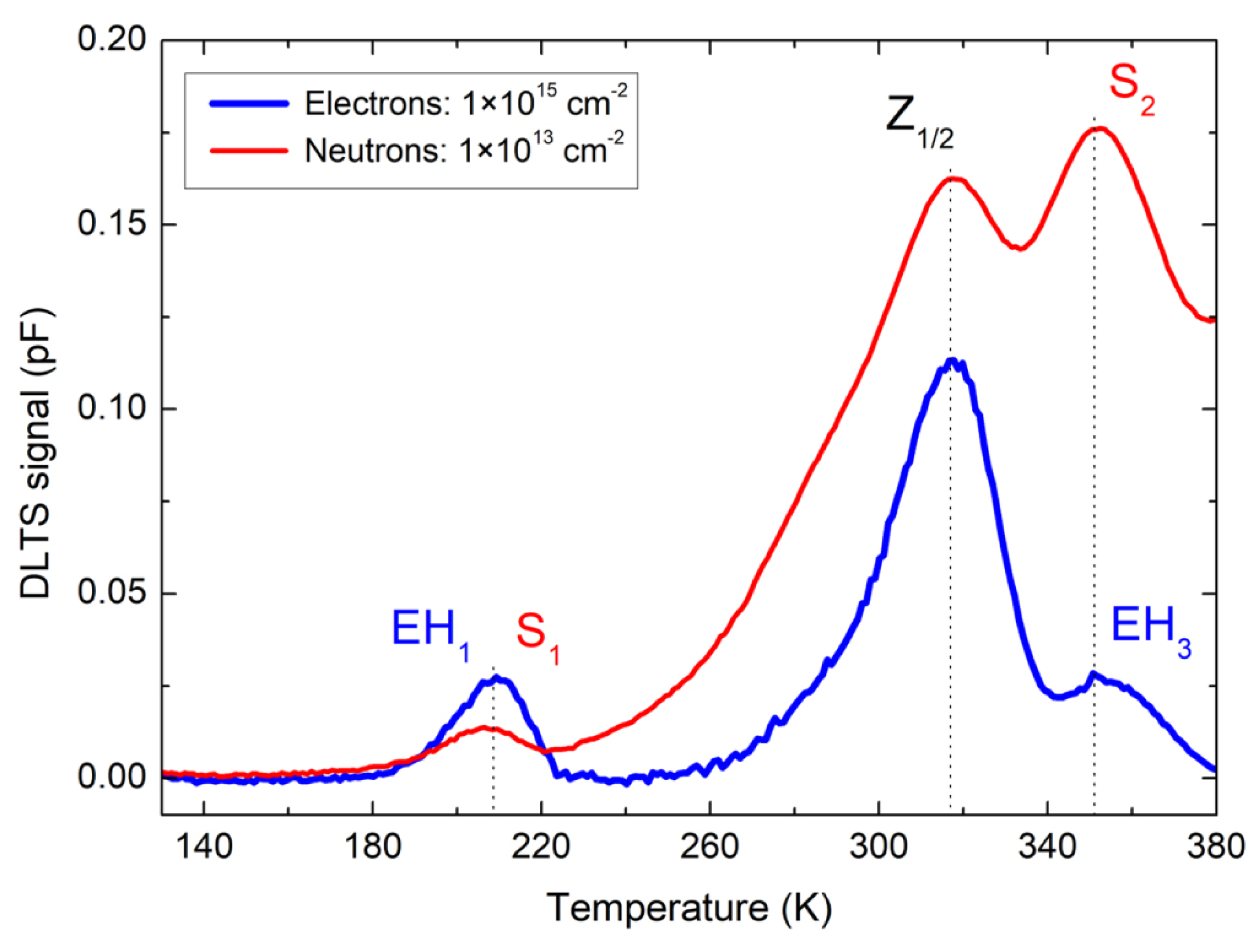
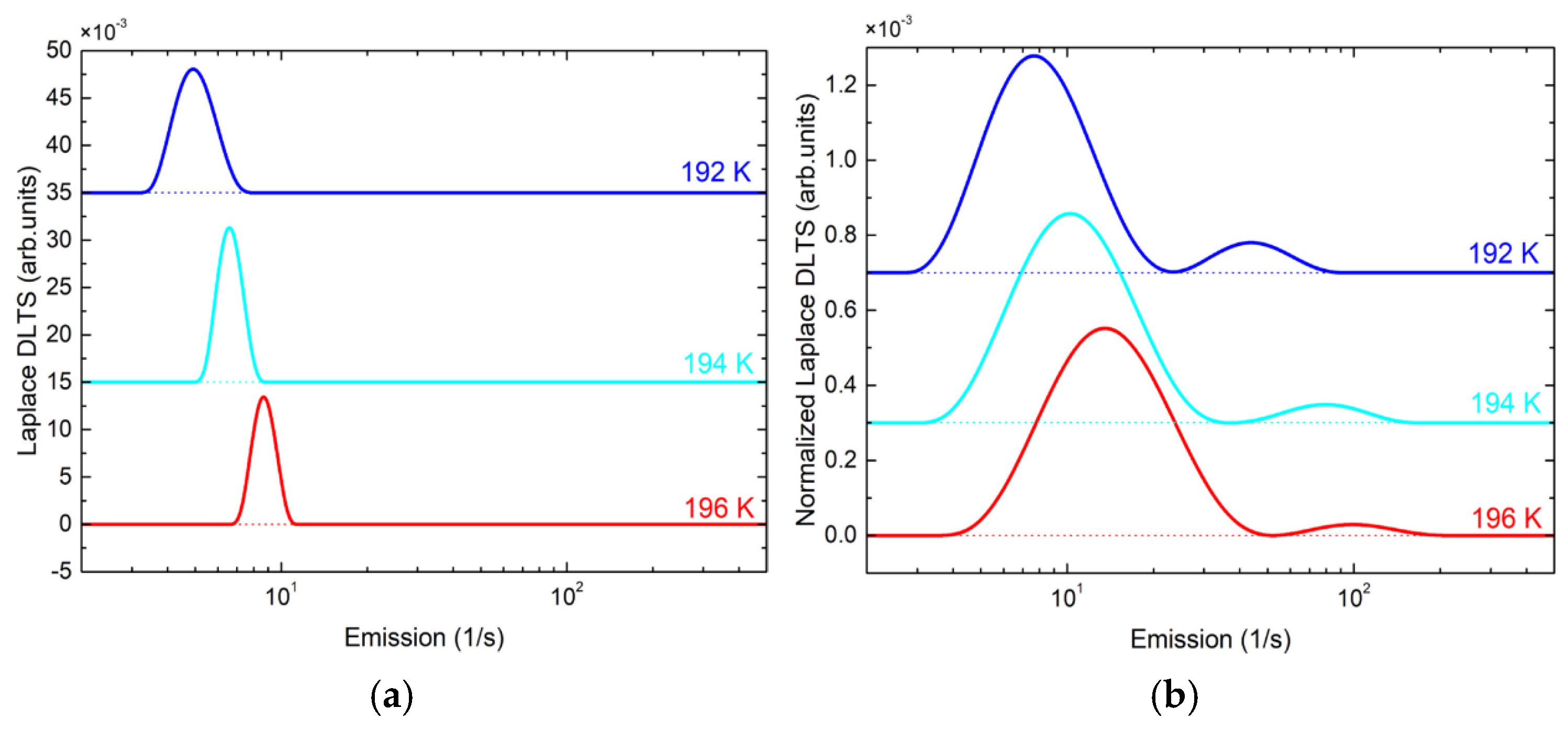
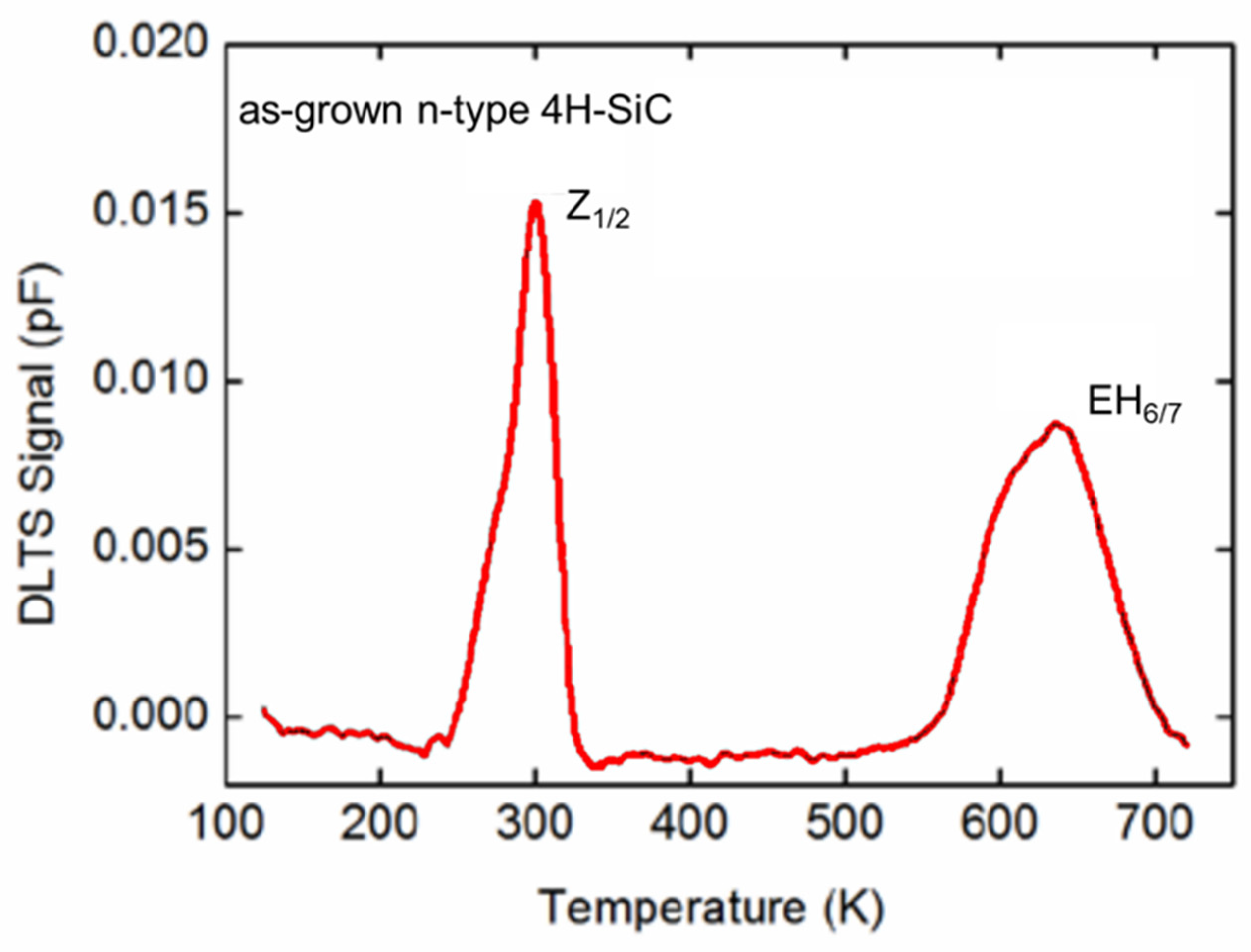


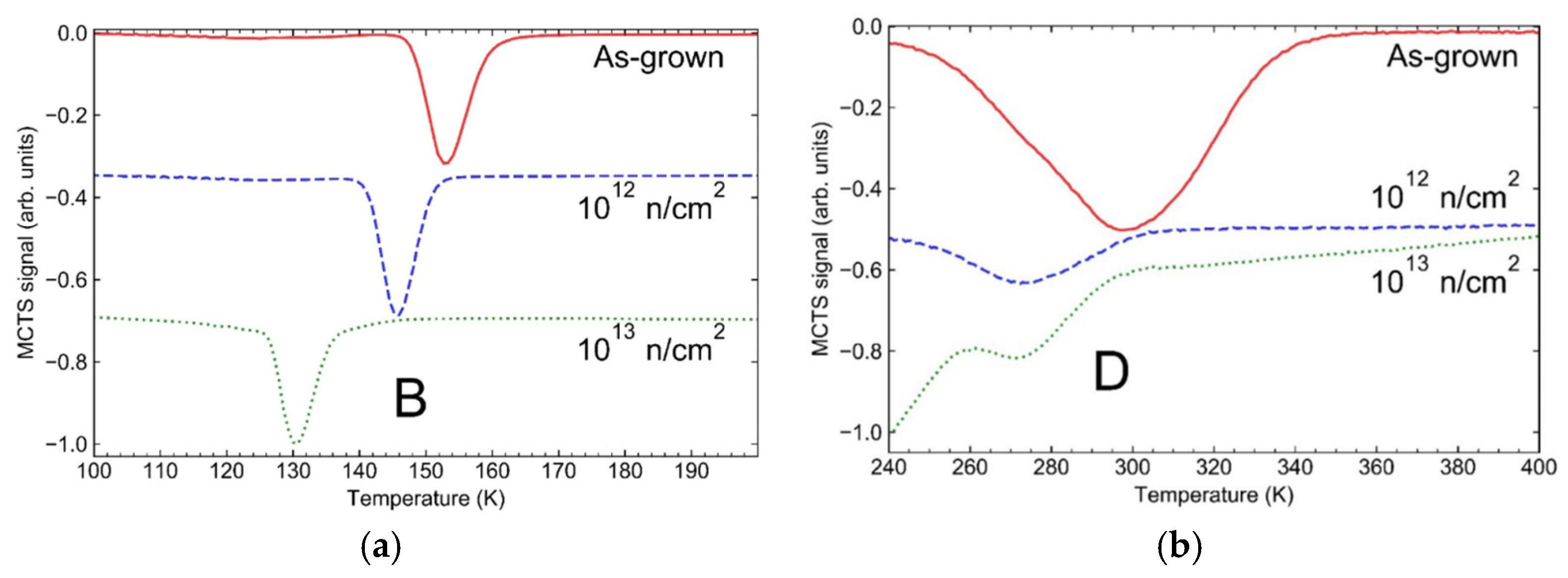
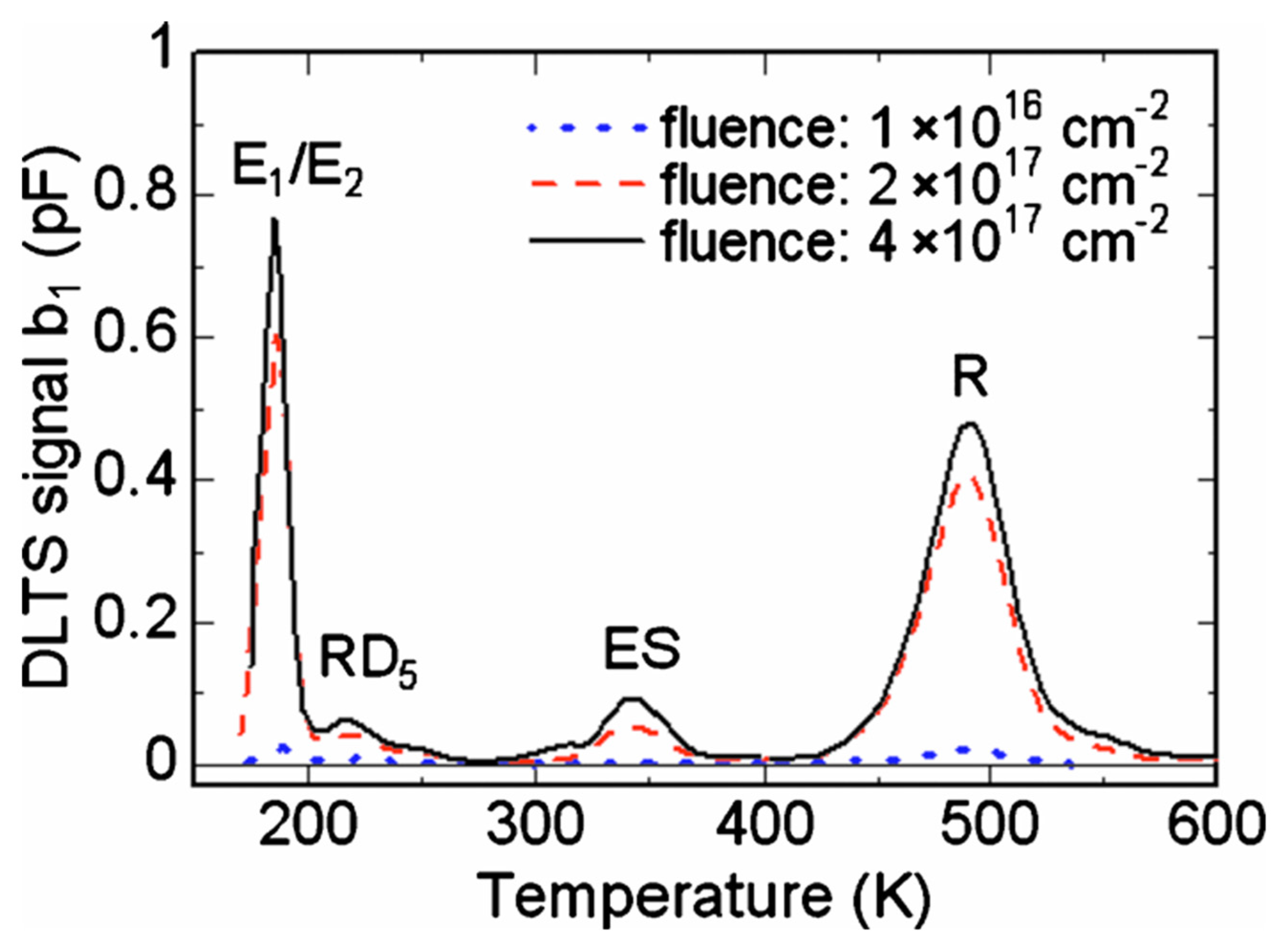
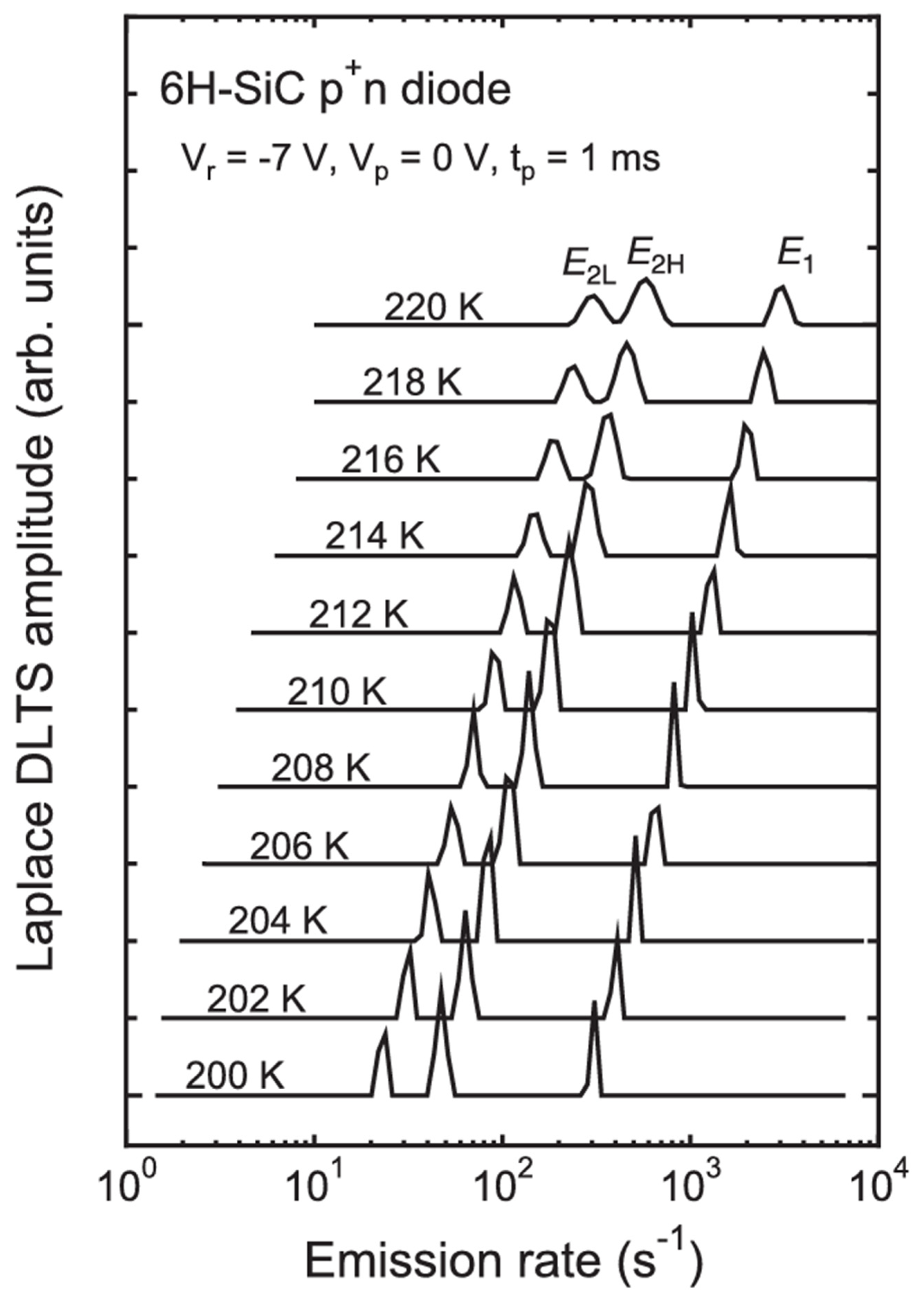
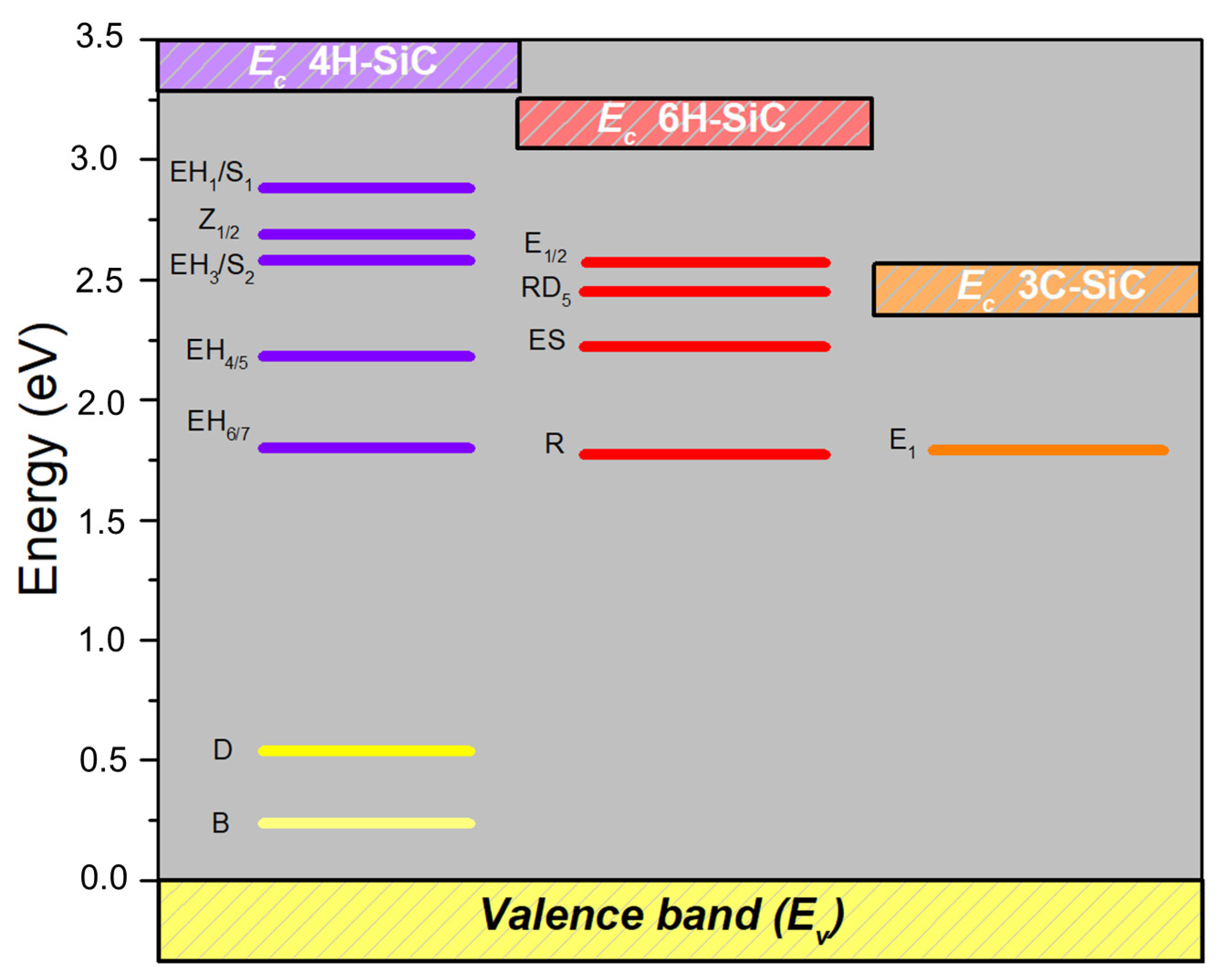
| SiC Polytype | Crystal Structure | Energy Band Gap (eV) | Electron Mobility||/⟂ to c-Axis (cm2V−1s−1) | Hole Mobility (cm2V−1s−1) | Thermal Conductivity (Wcm−1K−1) | Electric Field||to c-Axis (MV/cm) |
|---|---|---|---|---|---|---|
| 4H | Hexagonal | 3.26 | 1200/1020 | 120 | ~4.9 | 2.8 |
| 6H | Hexagonal | 3.02 | 100/450 | 100 | ~4.5 | 3.0 |
| 3C | Cubic | 2.36 | ~1000/1000 | 100 | ~3–4 | 1.4 |
| Trap Label | Identification | Activation Energy (eV) | References |
|---|---|---|---|
| EH1 | Ci | Ec − 0.40 | [35,36,37] |
| EH3 | Ci | Ec − 0.70 | [35,36,37] |
| S1 | VSi (-3/-) | Ec − 0.40 | [37,38,39] |
| S2 | VSi (=/-) | Ec − 0.70 | [37,38,39] |
| Z1 | Vc (=/0) | Ec − 0.59 | [49,50,51,52] |
| Z2 | Vc(=/0) | Ec − 0.67 | [49,50,51,52] |
| EH4 | CSi-VC | Ec − 1.00 | [56,57] |
| EH5 | CSi-VC | Ec − 1.10 | [56,57] |
| EH6 | Vc (0/++) | Ec − 1.30 | [53,54] |
| EH7 | VC(0/++) | Ec − 1.40 | [53,54] |
| B | BSi | Ev + 0.28 | [34,62,63,64] |
| D-center | BC | Ev + 0.61 | [34,62,63,64] |
Disclaimer/Publisher’s Note: The statements, opinions and data contained in all publications are solely those of the individual author(s) and contributor(s) and not of MDPI and/or the editor(s). MDPI and/or the editor(s) disclaim responsibility for any injury to people or property resulting from any ideas, methods, instructions or products referred to in the content. |
© 2025 by the author. Licensee MDPI, Basel, Switzerland. This article is an open access article distributed under the terms and conditions of the Creative Commons Attribution (CC BY) license (https://creativecommons.org/licenses/by/4.0/).
Share and Cite
Capan, I. Electrically Active Defects in 3C, 4H, and 6H Silicon Carbide Polytypes: A Review. Crystals 2025, 15, 255. https://doi.org/10.3390/cryst15030255
Capan I. Electrically Active Defects in 3C, 4H, and 6H Silicon Carbide Polytypes: A Review. Crystals. 2025; 15(3):255. https://doi.org/10.3390/cryst15030255
Chicago/Turabian StyleCapan, Ivana. 2025. "Electrically Active Defects in 3C, 4H, and 6H Silicon Carbide Polytypes: A Review" Crystals 15, no. 3: 255. https://doi.org/10.3390/cryst15030255
APA StyleCapan, I. (2025). Electrically Active Defects in 3C, 4H, and 6H Silicon Carbide Polytypes: A Review. Crystals, 15(3), 255. https://doi.org/10.3390/cryst15030255






